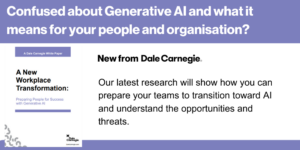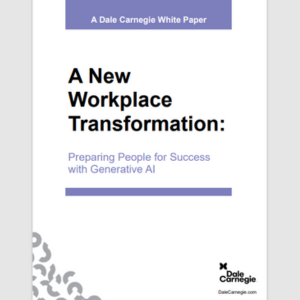
There’s many statements and stats surrounding the rapid emergence of AI into our lives and work:
- 37% of UK employees think that unemployment will ‘somewhat increase’ because of AI (Public First).
- By 2025, technology will create 12 million more jobs than it destroys ( World Economic Forum).
- Three quarters of employees believe that soft skills are the key to staying relevant in the advent of AI (Dale Carnegie Study).
Whatever way you look at it, the hard truth is that we are facing a global talent crisis – compounded by an ageing working population, growing global economies, and a change in attitude towards work by younger generations (evidenced by the estimated 85 million unfilled roles on the global job market in 2023). When integrated properly, therefore, generative AI can be seen as an effective solution to some of the difficulties businesses and organisations are currently staring down. It can enhance employee workflow, increase productivity, and it give people more time to be strategic and creative, to list but a few of its benefits. The key to long-term success here is to leverage technology without displacing your people.
If humans and AI can work together in a complementary and synergistic manner to achieve tasks and goals that neither could accomplish alone, their collaboration can lead to increased efficiency, improved decision-making, and the augmentation of human abilities.
10 Ways Humans and AI can Work Together
- Data Analysis and Insights:
- AI can process and analyse large volumes of data quickly, identifying patterns and trends that humans might miss.
- Humans can interpret and contextualise the insights generated by AI, applying domain expertise and critical thinking to make informed decisions.
- Automation of Routine Tasks:
- AI can handle repetitive and mundane tasks, freeing up human workers to focus on more creative, strategic, and value-added activities.
- Humans can oversee AI systems, ensure their accuracy, and intervene when exceptions or complex situations arise.
- Personalisation and Customer Service:
- AI-powered algorithms can personalise user experiences by analysing user preferences and behaviour.
- Humans can handle complex and emotionally sensitive customer interactions that require empathy, understanding, and human touch.
- Healthcare and Diagnosis:
- AI can assist medical professionals in analysing medical images, identifying potential issues, and suggesting treatment options.
- Medical experts can apply their clinical judgment, interpret results, and make final decisions based on AI-generated insights.
- Language Translation and Interpretation:
- AI can provide quick and automated translation of languages.
- Humans can refine translations, taking cultural nuances and context into account, ensuring accurate communication.
- Creative Collaboration:
- AI can generate ideas, designs, and content that serve as starting points for human creatives.
- Humans can refine, modify, and add their unique touch to AI-generated creative outputs.
- Safety and Security:
- AI can analyse data for potential security threats and anomalies.
- Humans can make strategic decisions based on AI recommendations and address nuanced security concerns.
- Scientific Discovery:
- AI can assist in data analysis, simulations, and pattern recognition in scientific research.
- Scientists can formulate hypotheses, design experiments, and interpret results in the context of broader scientific understanding.
- Learning and Education:
- AI can provide personalised learning experiences, adapting to individual student needs.
- Educators can guide students’ moral and ethical development, critical thinking, and social skills.
- Predictive Analytics and Decision Support:
- AI can forecast trends and outcomes based on historical data.
- Humans can evaluate potential implications, considering ethical, societal, and long-term factors before making decisions.
For effective collaboration between humans and AI, it’s important to:
- Define clear roles and responsibilities for both humans and AI systems.
- Ensure transparency and explainability of AI’s decisions.
- Continuously train and update AI models to adapt to evolving contexts.
- Cultivate a culture of learning, where humans embrace AI as tools for empowerment rather than replacements.
- Maintain human oversight, especially in critical decision-making areas.
The successful integration of humans and AI hinges on recognising each other’s strengths and limitations and fostering a collaborative environment that maximises their combined potential.
Powered by People, Supported by Technology
In the face of dramatic workplace change, our latest whitepaper will show how you can prepare your team’s transition towards AI by understanding the opportunities and threats. You will learn how organisations who prepare their employees for change and provide them with the right skills will be able to adopt and execute AI initiatives faster, enabling them to be more engaged, successful and to thrive.
For more than 100 years, we’ve helped companies of all sizes generate revenue, increase productivity and reduce costs by revealing their bright and resourceful workforce. Together, we’ll confront a changing workplace and set your organisation in motion to reach new heights, powered by the unique talents of your employees.
We can help you with:


